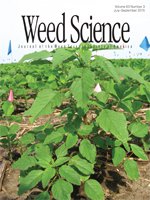Palmer amaranth, a dioecious summer annual forb, originating in Sonoran desert washes, compromises crop yields in much of the southern United States and its range is expanding northward. Appropriate tactics for managing this weed proactively in the Upper Midwest will depend on characterizing its damage niche, the geographic range in which it can reduce crop yields. We implemented a common garden study in 2011 and 2012, planting eight accessions of Palmer amaranth from the southern and midwestern United States, into soybean crops in southern, central, and northern Illinois, at a population density of 8 plants m−2 with a biocontainment protocol. Once Palmer amaranth plants initiated flowering, they were removed and burned. Weed survival, flowering, and weed biomass were measured, in addition to soybean yield and weather data. Analyses indicated that Palmer amaranth’s damage niche in Illinois soybean was independent of weed genotype or maternal environment. Despite competing only briefly, Palmer amaranth reduced soybean yields in all site–years, indicating its damage niche in Illinois, and much of the Midwest, is limited primarily by seed immigration rate. These results highlight the urgent need for weed managers to learn Palmer amaranth identification, prevent seed introduction, and maintain a policy of zero seed return.
Nomenclature: Palmer amaranth, Amaranthus palmeri S. Wats.; soybean, Glycine max (L.) Merr.






